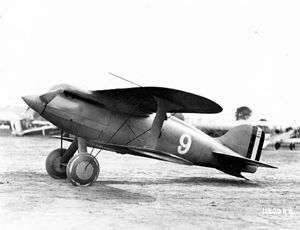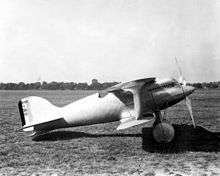Curtiss R2C
| Model 32, R2C, R-8 | |
|---|---|
 | |
| Role | Racing aircraft |
| Manufacturer | Curtiss Aeroplane and Motor Company |
| First flight | 9 September 1923 |
| Primary users | United States Navy United States Army |
| Number built | 3 |
|
| |
The Curtiss R2C was a racing aircraft designed for the United States Navy in 1923 by Curtiss. It was a single-seater biplane with a monocoque fuselage and staggered single-bay wings of unequal span braced with I-struts. The aircraft's advanced streamlining featured a top wing mounted directly to the top of the fuselage and surface-mounted radiators for cooling the engine. The aircraft was originally designed and built as a landplane under the Navy designation R2C-1,[1] of which two examples were produced. One was converted into a seaplane version known as the R2C-2 the following year.
Operational history


The R2C-1s were entered in the 1923 Pulitzer Trophy race, and took first and second places piloted by Lt jg Al Williams and Lt Harold Brow at average speeds of 243.67 mph (392.16 km/h) and 241.78 mph (389.11 km/h). Later in the year, Brow took one of the R2C-1s to 259.16 mph (417.06 km/h) and set a new world airspeed record. On 4 November 1923, Lieutenant Alford J. Williams, Jr., U.S. Navy, set a Fédération Aéronautique Internationale (FAI) World Record for Speed Over a 3-Kilometer Course of 429.03 kilometers per hour (266.59 miles per hour). (FAI Record File Number 8753) The second aircraft was sold shortly thereafter to the US Army for the token sum of $1. The Army designated it the R-8 and intended to race the aircraft against the Navy in the 1924 Pulitzer Trophy Race in Fairfield, Ohio, but it was destroyed in a crash during training shortly before the competition killing the pilot, First Lieutenant Alexander Pearson, Jr..[2]
The remaining R2C had its wheeled undercarriage replaced by pontoons during 1924 in preparation for that year's Schneider Trophy race, but the event was cancelled due to a lack of competitors. As it was, the aircraft won that year's Pulitzer Trophy in the seaplane class with an average speed of 227.5 mph (364.9 km/h). The aircraft ended its days training pilots for the 1925 and 1926 Schneider Trophy races.
Operators
Specifications (R2C-1)
General characteristics
- Crew: One pilot
- Length: 19 ft 3 in (5.867 m)
- Wingspan: 22 ft 0 in (6.706 m)
- Empty weight: 1,692 lb (767.5 kg)
- Gross weight: 2,112.3 lb (958.1 kg)
- Powerplant: 1 × Curtiss D-12A DOHC 4-valve V-12, 1,209.61 cubic inch (19.913 liter) displacement, 507 hp (378 kW)
Performance
- Maximum speed: 267 mph (430 km/h)
- Range: 173 miles (279 km)
- Service ceiling: 31,800 ft (9,695 m)
- Rate of climb: 2,380 ft/min (12.1 m/s)
See also
| Wikimedia Commons has media related to Curtiss R2C. |
- Related development
- Related lists
References
- Swanborough, Gordon; Peter M. Bowers (1976). United States Navy Aircraft since 1911. London: Putnam. ISBN 0-370-10054-9.
- Taylor, Michael J. H. (1989). Jane's Encyclopedia of Aviation. London: Studio Editions. p. 796.
- World Aircraft Information Files. London: Bright Star Publishing. pp. File 891, Sheet 46.